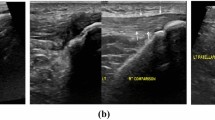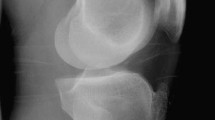Abstract
Purpose
Tendinous lesions are among the most frequent pathologies encountered in sportsmen. The objectives of new treatments are to improve the healing process and reduce the recovery time. Boron plays an important role in the wound repair process by increasing components of extracellular matrix and angiogenesis. This animal study aimed to investigate the effect of boric acid on healing of the Achilles tendon.
Methods
The right Achilles tendons of 40 rats were completely sectioned, and the rats were randomly divided into five groups. Each group consisted of eight rats. Groups 1 and 2 were oral boric acid groups with the doses of 4 and 8 mg/kg/day boric acid, respectively. Group 3 was the local boric acid group (8 mg/kg boric acid intratendinous injection). Group 4 was administered both oral and local boric acid (8 mg/kg/day orally and 8 mg/kg boric acid intratendinous injection), and group 5 was the control group with no boric acid application. At the end of the fourth week, all the rats were killed and histopathological examination of the Achilles tendon repair site was made.
Results
Histopathological examination of the tissue sections revealed more properly oriented collagen fibres, more normal cellular distribution of tenocytes and more properly organized vascular bundles in group 1 and group 2, which were the groups administered oral boric acid. Pathological sum scores of groups 1 and 2 were less than those of the other groups, and the differences between the oral boric acid groups (group 1 and group 2) and the other three groups (groups 3, 4 and 5) were statistically significant (p = 0.001).
Conclusion
As boric acid is safe and toxicity even after very high doses is unusual, oral boric acid may be used as an agent to improve the healing process of tendon injuries. However, biomechanical tests should also be performed to show the effect of boric acid on strength and endurance of the tendon before it can be used in clinical practice.



Similar content being viewed by others
References
Aras MH, Sezer U, Erkilic S, Demir T, Dagli SN (2013) Effect of dietary boron on 5-fluorouracil induced oral mucositis in rats. Eur J Dent 7(3):310–314
Aspenberg P, Forslund C (1999) Enhanced tendon healing with GDF 5 and 6. Acta Orthop Scand 70:51–54
Aspenberg P, Virchenko O (2004) Platelet concentrate injection improves Achilles tendon repair in rats. Acta Orthop Scand 75:93–99
Benderdour M, Hess K, Dzondo-Gadet M, Nabet P, Belleville F, Dousset B (1998) Boron modulates extracellular matrix and TNF alpha synthesis in human fibroblasts. Biochem Biophys Res Commun 246(3):746–751
Benderdour M, Hess K, Gadet MD, Dousset B, Nabet P, Belleville F (1997) Effect of boric acid solution on cartilage metabolism. Biochem Biophys Res Commun 234(1):263–268
Blech MF, Martin C, Borrelly J, Hartemann P (1990) Traitement des plates profondes avec perte de substance; Interet d’une solution d’acide borique 3 %. Presse Medicale 19:1050–1052
Blech MF, Martin C, Pichon C, Borrelly J, Hartemann P (1990) The clinical and bacteriologic outcome of wounds using different local antiseptics. J Orthop Surg B 4:123–129
Cao J, Jiang L, Zhang X, Yao X, Geng C, Xue X (2008) Boric acid inhibits LPS-induced TNF-alpha formation through a thiol-dependent mechanism in THP-1 cells. J Trace Elem Med Biol 22:189–195
Carmont MR, Maffulli N (2008) Modified percutaneous repair of ruptured Achilles tendon. Knee Surg Sports Traumatol Arthrosc 16:199–203
Cetti R, Henriksen LO, Jacobsen KS (1994) A new treatment of ruptured Achilles tendons: a prospective randomized study. Clin Orthop Relat Res 308:155–165
Chong AK, Ang AD, Goh JC, Hui JH, Lim AY, Lee EH, Lim BH (2007) Bone marrow-derived mesenchymal stem cells influence early tendon-healing in a rabbit Achilles tendon model. J Bone Joint Surg Am 89:74–81
Devirian TA, Volpe SL (2003) The physiological effects of dietary boron. Crit Rev Food Sci Nutr 43(2):219–231
Doral MN (2013) What is the effect of the early weight-bearing mobilisation without using any support after endoscopy-assisted Achilles tendon repair? Knee Surg Sports Traumatol Arthrosc 21(6):1378–1384
Doral MN, Bozkurt M, Turhan E, Ayvaz M, Atay OA, Uzumcugil A, Leblebicioglu G, Kaya D, Aydog T (2009) Percutaneous suturing of the ruptured Achilles tendon with endoscopic control. Arch Orthop Trauma Surg 129:1093–1101
Fenwick SA, Hazleman BL, Riley GP (2002) The vasculature and its role in the damaged and healing tendon. Arthritis Res 4:252–260
Forslund C, Bylander B, Aspenberg P (2003) Indomethacin and celecoxib improve tendon healing in rats. Acta Orthop Scand 74:465–469
Gelberman RH, Amifl D, Gonsalves M, Woo S, Akeson WH (1981) The influence of protected passive mobilization on the healing of flexor tendons: a biochemical and microangiographic study. Hand 13:120–128
Gigante A, Moschini A, Verdenelli A, Del Torto M, Ulisse S, de Palma L (2008) Open versus percutaneous repair in the treatment of acute Achilles tendon rupture: a randomized prospective study. Knee Surg Sports Traumatol Arthrosc 16:204–209
Goren D, Ayalon M, Nyska M (2005) Isokinetic strength and endurance after percutaneous and open surgical repair of Achilles tendon ruptures. Foot Ankle Int 26:286–290
Hunt CD (1994) The biochemical effects of physiologic amounts of dietary boron in animal nutrition models. Environ Health Perspect 102(Suppl. 7):35–43
Kaya D, Doral MN, Nyland J, Toprak U, Turhan E, Donmez G, Citaker S, Atay OA, Callaghan MJ (2013) Proprioception level after endoscopically guided percutaneous Achilles tendon. Knee Surg Sports Traumatol Arthrosc 21(6):1238–1244
Khan KM, Maffulli N (1998) Tendinopathy: an Achilles’ heel for athletes and clinicians. Clin J Sport Med 8:151–154
Maffulli N, Del Buono A, Spiezia F, Longo UG, Denaro V (2012) Light microscopic histology of quadriceps tendon ruptures. Int Orthop 36(11):2367–2371
Maffuli N, Longo UG, Franceschi F, Rabitti C, Denaro V (2008) Movin and Bonar scores assess the same characteristics of tendon histology. Clin Orthop Relat Res 466(7):1605–1611
Maffulli N, Wong J, Almekinders LC (2003) Types and epidemiology of tendinopathy. Clin Sports Med 22:675–692
Movin T (1998) Aspects of aetiology, pathoanatomy and diagnostic methods in chronic mid-portion achillodynia. Karolinska Institute, Stockholm, pp 1–51
Nielsen FH, Hunt CD, Mullen LM, Hunt JR (1987) Effect of dietary boron on mineral, estrogen, and testosterone metabolism in postmenopausal women. FASEB J 1:394–397
Nzietchueng RM, Dousset B, Franck P, Benderdour M, Nabet P, Hess K (2002) Mechanisms implicated in the effects of boron on wound healing. J Trace Elem Med Biol 16(4):239–244
Omeroglu S, Peker T, Turkozkan N, Omeroglu H (2009) High-dose vitamin C supplementation accelerates the Achilles tendon healing in healthy rats. Arch Orthop Trauma Surg 129:281–286
Pawa S, Ali S (2006) Boron ameliorates fulminant hepatic failure by counteracting the changes associated with the oxidative stress. Chem Biol Interact 160:89–98
Rainey C, Nyquist L (1998) Multicountry estimation of dietary boron intake. Biol Trace Elem Res 66:79–86
Thomopoulos S, Soslowsky LJ, Flanagan CL, Tun S, Keefer CC, Mastaw J (2002) The effect of fibrin clot on healing rat supraspinatus tendon defects. J Shoulder Elbow Surg 11:239–247
Tuzuner S, Ozkan O, Erin N, Ozkaynak S, Cinpolat A, Ozkan O (2015) Effects of botulinum toxin A injection on healing and tensile strength of ruptured rabbit Achilles tendons. Ann Plast Surg 74:496–500
Williams IF, Nicholls JS, Goodship AE, Silver IA (1986) Experimental treatment of tendon injury with heparin. Br J Plast Surg 39:367–372
Woods WG (1994) An introduction to boron: history, sources, uses, and chemistry. Environ Health Perspect 102(Suppl. 7):5–11
Zhang F, Liu H, Stile F, Lei MP, Pang Y, Oswald TM, Beck J, Dorsett-Martin W, Lineaweaver WC (2003) Effect of vascular endothelial growth factor on rat Achilles tendon healing. Plast Reconstr Surg 112:1613–1619
Conflict of interest
All authors have no conflicts of interest with respect to the data collected and procedures used within this study.
Author information
Authors and Affiliations
Corresponding author
Rights and permissions
About this article
Cite this article
Kaymaz, B., Gölge, U.H., Ozyalvaclı, G. et al. Effects of boric acid on the healing of Achilles tendons of rats. Knee Surg Sports Traumatol Arthrosc 24, 3738–3744 (2016). https://doi.org/10.1007/s00167-015-3617-5
Received:
Accepted:
Published:
Issue Date:
DOI: https://doi.org/10.1007/s00167-015-3617-5




